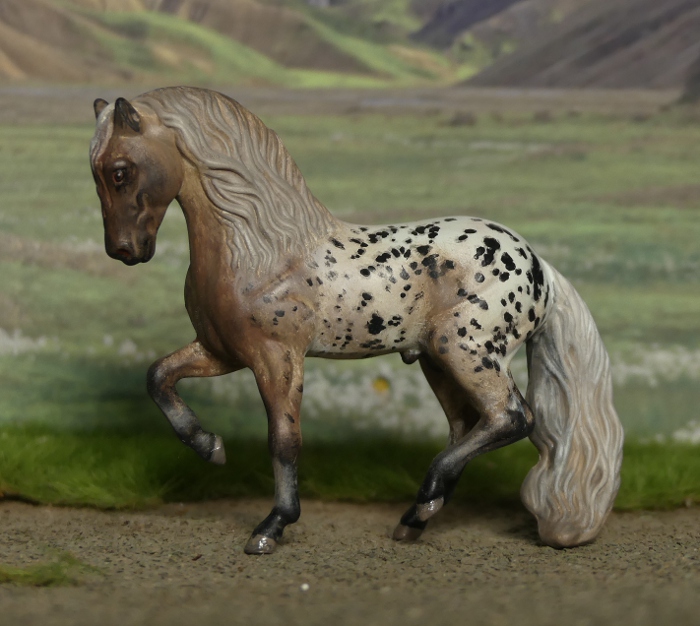He came about as a result of me thinking 'I have loads of this rearing mould, what could I do with it?', and also musing that I've hardly ever painted leopard appaloosas, most of mine have been blanket spotted, or roany semi-leopard. So it was a logical combination to put the appy paintjob on one of the rearing arabian bodies! He's buckskin, under his spotting pattern, so the spots on his body are a different colour to those on his legs.
Another colourful appaloosa, this time a flaxen chestnut with four long socks and a blaze, with my usual roany blanket type pattern. I'm getting much better at blonde manes and tails since I found the right creamy beige colour pre-mixed!
I also found a really good method for getting the distinct sclera (eyewhites) that come with the appaloosa coat pattern : some very diluted pink paint touched against the eyeball while the horse is held on his side - the fluidity of the paint draws it right down into the crease between eye and lid all the way around, then once it's dried you can paint in the eye as usual.
And the final spotted horse is something of an oddity, being not quite an art portrait recreated with heavy resculpting of an existing mould (as I did for Whistlejacket and Cerbero), but inspired by an oil painting, anyway.
With no standing Iberian-type SM mould to work from, and being increasingly averse to major resculpting projects, I decided the only way I'd ever make a model version of him was to pick from what I'd got and go with it while I was in an enthusiastically painty mood, and so at last he's happened!
I'm extremely happy with how he turned out, roany smudgey mottled colours I find very stressful as there's so much opportunity to just make a blotchy mess when brush-painting by hand, it can go all wrong in one application of ever so slightly too much paint, or the wrong consistancy cos the air's drying it too much or you've tried to counteract that with a little too much licking of the brush...it's kind of scary, but super satisfying to relax when it's over. Maybe being glad it's over isn't really the same as enjoying painting and I'm in the wrong hobby, hahah.
Another angle, as well as attempting to get the spots in the same places I tried my hardest to get the shading just the same, with some more blended and some more speckled, and the deepest colour on the face, the front of the shoulders, and the legs.
I'm not entirely sure what to make of this colour, in technical specifics - my best guess is that his base colour is seal or sooty bay, or possibly a dark bay dun, with the leopard complex lightening and mottling it up, and also causing the pale mane and tail through roaning rather than any kind of additional silver gene on top.
But the stand-out contradiction to this is that his spots are black, not bay/dun. Usually, an appaloosa's spots are whatever his solid base colour would've been. Sometimes they do look much darker, so you can see spots on the 'bay' front half of a bay blanket appaloosa, for example, but that's cos the appaloosa lightens the body colour with what can be subtle roaning of the coat even outside of the distinct white blanket area, and the true base colour is always what you're seeing in the spots. So really, this horse's spots should be painted in shades of brown, but to be true to the original oil painting, I stuck with black.
This side is a mirror image of the other! Usually, if using a single photo reference for inspiration, I'd just make something up for the side I couldn't see, but this time it's complicated - I really wanted the clear side of his neck and shoulder to carry an exact copy of the pattern - his mane covers so much of this side I'd have lost the chance to recreate all that roaning and some of the spots, but of course the painting is of the left side, so if I invented some similar-but-different pattern, he wouldn't actually match the portrait when facing the same way. So he gets to be the only appaloosa in my herd who has the same spots on both sides!






Ahhh! You really need to paint more spotty ponies, clearly, because these are fantastic! I'm not the biggest fan of any of those moulds but you've made them absolutely stunning, especially the first one.
ReplyDeleteYeah, I wouldn't list them among my favourite moulds, I like the andalusian more than the other two but never have been a fan of the way the forelock goes down the front of the face, and oddly enough I started liking the reiner more when I started painting them!
DeleteI think I probably will do more appies while I'm in painting mode, I've got a few more stock breed SMs, and in the Hiding Place of Guilt I Didn't Paint It Yet corner of resins doing the out-of-sight-out-of-mind thing there's a Wee Wyakim who's been awaiting a spotted paintjob ever since the poor thing arrived here...uh....a decade ago maybe?